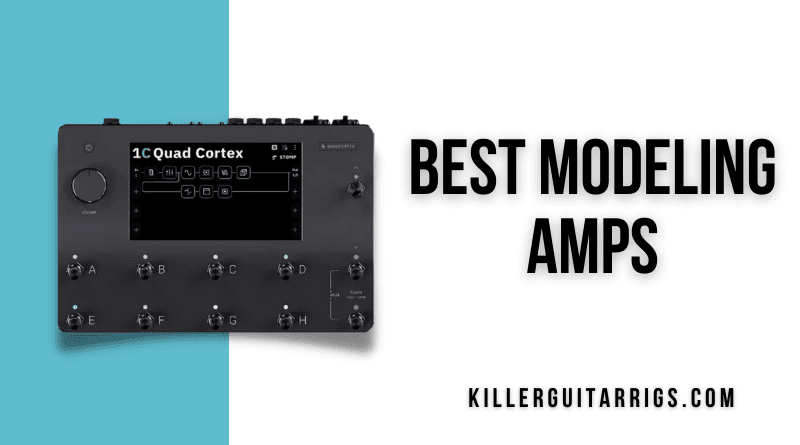It’s easier than ever to match the tones of some of the world’s most famous amps thanks to modern digital technology, and with any one of the best modeling amps, you’re going to have a range of authentic sounding amp models to perfectly recreate those sounds – a great starting point is the Boss Katana 50 MKII, which is one of our most awarded amplifiers. This 50 watt combo amp delivers incredible modeling capabilities and almost limitless customization options thanks to its range of built in voicings, effects, and of course, the vast online community of Katana users. Models are easy to install using the Boss Tone Studio companion software, making it an absolute breeze to dial in the exact tone you’re looking for. It’s an incredibly well built amp, and thanks to its built in attenuation, works brilliantly for everything from quiet bedroom level practice, to gigs in small to medium venues. The Boss Katana 50 MKII is one of the most versatile models on the market, period, and that’s why we’ve named it as our best modeling amps Top Pick.
Players working with a bigger budget should definitely check out the Neural DSP Quad Cortex. In terms of modeling accuracy, it’s the reigning champ – it benefits from a huge online community, and allows for the operation of four signal chains simultaneously, making it capable of incredible detail. It delivers everything you could ever need in a digital rig, including amp simulations, cabinet IRs, effects, looper capability, and it’s so easy to use thanks to its touch screen interface. It’s extremely well made, with an all aluminum body, which ensures that it can stand up to everything from stage use to commercial studio settings. It’s genuinely one of the most impressive modeling amps ever built, and for that reason, it’s our best modeling amps Editor’s Choice winner.
If you don’t need the kind of power offered by the Katana 50 or the Quad Cortex, and you want to keep costs to a minimum while still getting great sound quality and aesthetics, look no further than the Yamaha THR5. This is a compact 10 watt amp suitable for players of all abilities. It offers a portable solution for both practice and recording thanks to its USB interface functionality. Out of the box, it features five voicings: Clean, Crunch, Lead, Brit Hi, and Modern, alongside a range of built in effects including chorus, flanger, phaser, and tremolo, plus four different delay and reverb effects. On top of this, it’s still capable of running amp models shared by others online, and using the companion software you can even make your own. Despite being an affordable option, it still delivers great sound quality and tons of features, so it’s the clear choice as the winner of our best modeling amps Best Budget award.
Read more about our review process.

Neural DSP Quad Cortex
Features: Quad core processor, 7" touchscreen display, On boatd 48v phantom power
Benefits: Amazing profiling/modeling accuracy, Extremely compact, Simple to use

Boss Katana-50 MkII
Features: 5 Preset amp voicings, Cab emulated outputs, Power amp input
Benefits: Incredibly versatile performance, Simple parameter adjustments, Huge aftermarket modeling support
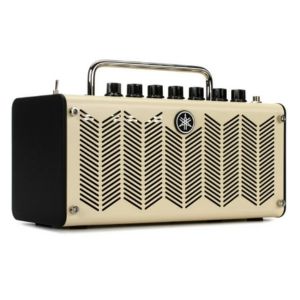
Yamaha THR5
Features: Battery power option, USB interface functionality, Built in reverb/delay FX
Benefits: Extremely portable, Great stereo sound, Easy to use control app
Contents
Individual Reviews
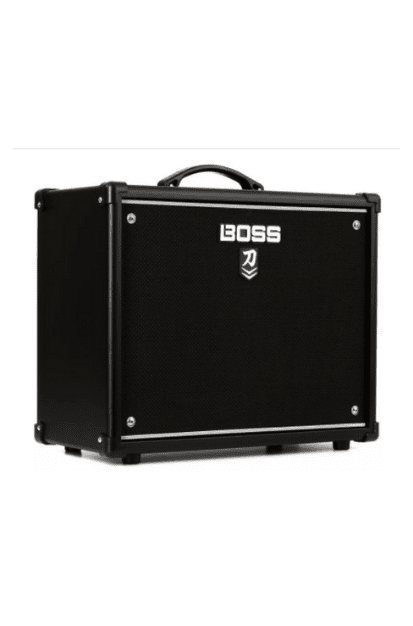
Boss Katana 50 MKII
Incredible tones and incredible value from Boss.
This Boss modeling amp delivers incredible tones, features a fantastic combo speaker setup, and has user friendly software. Boss measure their power as a tube equivalent, so you're getting an amp that works as well in the studio as it does on stage.
The Boss Katana 50 MKII (full review here) is one of the most popular combo amps on the market today, and that includes non-modeling amps! It’s packed with some of the best tones you’ll find in any sub-$1000 amp, and yet it costs less than $300.
As mentioned, this is a combo amp, so it has a very classic appearance. The Katana 50 is very well made, with quality materials used throughout. The control layout is also quite traditional, which converts from standard tube or solid-state amps. If the layout isn’t good, digital displays can be a bit overwhelming when you first get into modelers and profilers. Controls are mounted up top, and from there you can access all of the built-in features of the amp.
The Katana 50 has 5 different amp models built in: Acoustic, Clean, Crunch, Lead, and Brown. These preset amp models aren’t emulated after a particular amp or cab, but it doesn’t stop them from sounding excellent! We got creamy tones with punchy mids and well-defined trebles on the acoustic and clean channels. Crunch was excellent, too, sounding just like an authentic tube amp on the verge of breakup. Lead got us some soaring trebles with a balanced mid and low end, and Brown hits with an unmistakable growl.
There were 60 pre-loaded FX available, and as with much more expensive models, you can store up to 5 in a signal chain that can be loaded to your Katana via the Boss Tone Studio. There are, of course, more amp and pedal models available to download, and everything can be modified to suit your taste.
The cab is equipped with a high-performance 12” speaker. It’s a Boss branded model and we thought it performed incredibly, going to show that you don’t need a Celestion or Jensen to sound good. A particular favorite feature for the KGR team was the “attenuator” switch. While not a true attenuator, it does allow you to select between 0.5, 25, or 50 watts. We found that this let us turn the Katana down to bedroom levels without sacrificing tone. And best of all, we could crank it to small-venue levels without interfering with EQ settings.
Verdict: We stand by our opinion that the Boss Katana 50 MKII is the gold standard when it comes to small-combo amps that can be used for everything from bedroom volumes to small gigs. It’s easy to use, built to last, has tons of aftermarket support, and the sound quality is far superior to similarly-priced modeling-combo amps.
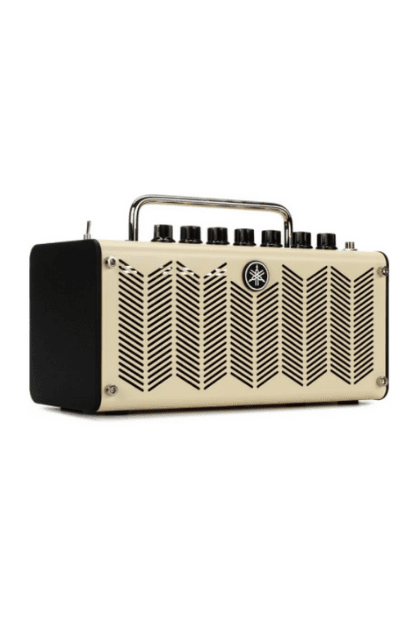
Yamaha THR5
Effortlessly cool and awesome sound quality.
You'll find the usual Yamaha level of attention to detail in this desktop modeler (extremely high if you weren't aware). It's compact, looks fantastic, and sounds incredible considering it only makes use of a pair of 3" stereo speakers.
The Yamaha THR5 is the smallest in Yamaha’s range of desktop amplifiers. Within this particular niche, this is a special amplifier (full review here). As with pretty much everything from Yamaha, it’s something of an underdog product, but it’s absolutely worthy of your attention if you’re looking for a small, affordable modeling combo.
This is by no means a loud amplifier. It’s rated to 10 watts (running on mains or battery power) and has 2 x 3” speakers, but it’s perfect for its intended use, which is typically bedroom or music-room practice. It can also serve as a USB interface, so if you’re planning to record, you’ll be able to plug the THR5 right into your chosen DAW.
There are a total of 5 preset amp voicings in the THR5, starting with Clean, which was incredibly crisp and remained so even at higher volume. Crunch gave us just a touch of tube-on-the-verge-of-breakup overdrive. Lead was creamy, and very full in the mids. Brit Hi gave us some growling Marshall tube tones. Finally, the Modern mode, which gave us a high-gain effect, without pushing over the edge into distortion.
With this range of amp voicings, plus the combination of 4 modulation effects and 4 reverb and delay effects, we were able to dial in some great tones. We previously tested two of the larger versions of this amp, the THR10 and THR30 ii, and we were equally as impressed with the THR5’s sound quality across all of the models and FX (it even stood up well against the big daddy, the Boss Katana)
If you’d prefer to manipulate the presets and come up with your own voicings, you can do so in the Yamaha THR editor. We really liked this editing software. It was simple to use and gave a lot of customization options.
Verdict: While there’s no escaping the fact that the Yamaha THR5 is a practice amp, it’s still exceptionally versatile. The ability to use it as a USB interface alone makes this model worth the purchase price. Other perks are the great model voicings, the simple but effective FX, and the excellent build quality.
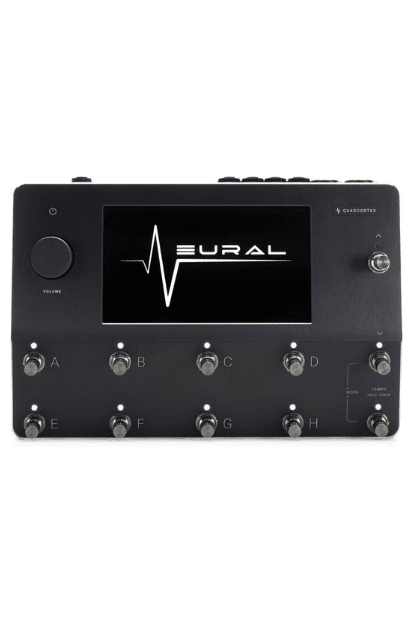
Neural DSP Quad Cortex
The profiler that has everybody’s attention.
This is one of the most high tech profilers ever to hit the market. The Quad Cortex can create exact replicas of any amp or pedal, and fool even the keenest ears into believing that they are hearing the real thing.
Everybody on the KGR team has been a big fan of the Quad Cortex since its launch, and for good reason.
The physical form of the Quad Cortex may be a little deceiving if you’re not too familiar with the world of modelers and profilers. The QC is in pedal form and isn’t technically an amp at all. It’s a profiler that can capture pretty much any pedal or amplifier in existence. We found that tonally, it sounds just like the real thing when amplified. We tested quite a few amps, cabs, and pedals, and we were hard-pressed to identify which was the original and which was the QC on playback.
We tested this unit with an Orange Pedal Baby 100 into an Orange PPC112 1×12” cab, with an effective 60w output. There are differing schools of thought as to whether you should run a Quad Cortex through a solid state or a tube/hybrid power amp. Some say that tubes provide too much color to the profiles, while others say that tubes help to “un-digitize” the sound. We only got a chance to run it through a solid-state power amp, but we can confirm that it still sounded incredible.
If you’d prefer to run your Quad Cortex directly through a PA rather than through a cab, you can absolutely do so. In fact, you won’t even need the additional power amp to run it this way. Alternatively, you can use it as a USB interface.
There are a wide range of excellent built-in amplifier profiles to play with. If they aren’t to your liking, you can either modify them in the Neural DSP software, choose from thousands of pre-captured profiles from the internet, or profile them yourself with the Neural Capture functionality.
The user interface is one of the single most impressive things about the Quad Cortex. It has a big, bright LED touchscreen display, and each of the menus is intuitive, so you can get started right away without even opening the manual!
We loved how easy it was to switch between settings using the foot switches, too. It genuinely felt like using a real pedalboard and amp setup, and distracted us completely from the fact that this unit isn’t even an amplifier itself!
Verdict: The aim of modeling amps and profilers is to accurately replicate other amplifiers, and none do it better than the Neural DSP Quad Cortex. Everything about it is simple and straightforward to use, so beginners and amateurs can enjoy the benefits of the QC, just as pros can. Profiles are easy to download and just as easy to capture, plus there’s endless hours of fun to be had in tweaking them.
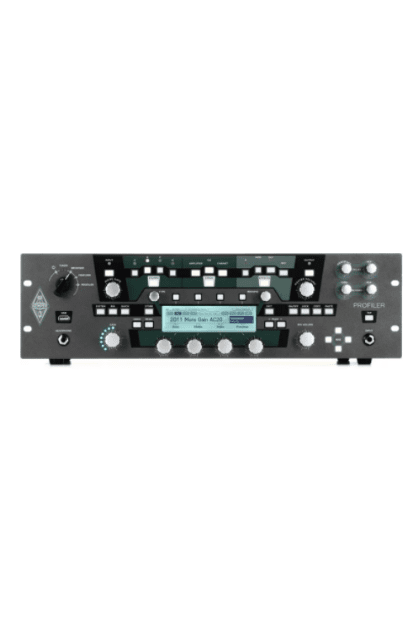
Kemper Profiler Head
Exceptional build quality and incredibly accurate profiles.
With this amp you're getting the profiler that started the revolution. It's not new, but it's managed to remain relevant in a sea of current competition. It offers incredible quality profiles out of the box, and a community of 10s of thousands creating new profiles every day online.
The Kemper Profiler was the device that really put profilers on the map. It’s been a mainstay of both amateur and sound-engineering professionals for years now, all thanks to its reputation as one of the best amp profilers on the market.
This particular model works as a preamp, meaning you will need to run it through a power amp before sending it to an unpowered cab. For this test, as we did with the Quad Cortex, we ran it through the Orange Power Baby into a 60w Orange 1×12” cab.
Kemper’s reputation for profiling accuracy is well-earned. The preset amp profiles were all great, and without knowing that the tone was coming from a Kemper, you’d be hard pressed to tell it was a solid-state amp and not a real tube amp playing.
The Profiler comes with 60 built-in effects, and of course there is an enormous worldwide community of Kemper enthusiasts sharing literally thousands of amp, cab, and pedal profiles, all of which are available to download (check out our favorite profiles here). As we’ve pointed out in previous reviews of the Kemper, the built-in effects are pretty lifeless in comparison to those on other premium profilers like the Quad Cortex, but they can all be modified and there are thousands of others to choose from online.
One thing that is likely to put off newer players or those just getting started with modeling is the sheer number of knobs, dials, and controls on the unit. It’s quite intimidating to look at and the overall interface isn’t the most user-friendly.
Verdict: The Kemper Profiler Head is, despite some relatively minor shortcomings, still a competitive profiler, even though it’s been on the market for over 10 years without any major changes. It offers a broad range of functionality, accurate amp, cab, and pedal profiles, and it’s as portable as any other amp head.
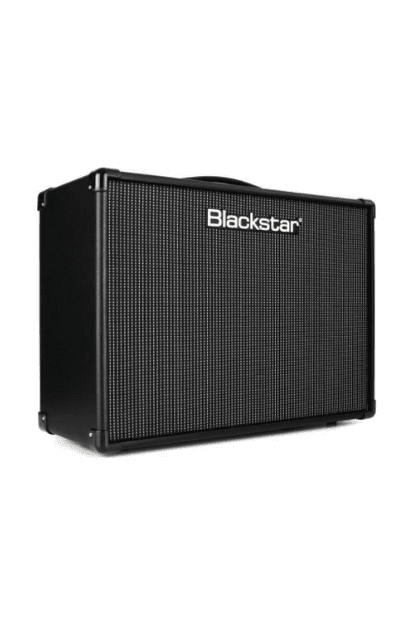
Blackstar ID:Core 100
The best modeling amp that you’ve probably never heard of.
This combo is perfect for everything from jam sessions to live performance. With 100 watts on hand, it has enough power to keep up with a band, and the quality of the models is incredible considering the price.
Blackstar was founded in 2007 by a group of former Marshall employees, including their former chief design engineer. They offer some great products at great prices, and are often overlooked as buyers turn to bigger names like Marshall, Vox, and Orange for their British voiced-amp needs.
The Blackstar ID:Core 100 is combo amp, so you’re getting the amplifier and speakers built into a cab. In this case, there are 2 x 10” speakers driven by the 100-watt amplifier, so it’s the most powerful combo amp we tested today, aside from the Quad Cortex which is driven by a 100-watt Orange power amp.
There are 6 preset amp voicings, including two clean channels (Clean Warm and Clean Bright). We loved the Clean Warm for its well-balanced mids, but Clean Bright was lacking presence. Crunch gave some really nice tube tones, while Super Crunch gave us the effect of fully-saturated tubes being pushed to the limit. The final 2 voicings are Overdrive 1 and Overdrive 2. Both are equivalent to the lead tones we found on some of the others, although OD2 had noticeably more gain than OD1.
The EQ controls allowed us to further adjust the tone of each of the amp voicings individually, as did the “ISF” control. ISF stands for Infinite Shape Feature, with the theory being you can shift from a warm and crunchy British sound (turn the dial clockwise) to a crisp, punchy American voicing (turn the dial counter-clockwise). In reality, it’s little more than a tone control in reverse. It’s not bad, but it doesn’t really do anything unique. The FX are really one of the strongest points for the Blackstar. There are modulation, reverb, and delay effects you can choose from, and there is even an octaver function.
The octaver isn’t as effective as we hoped it would be and sounds a little too digital. The one outstanding function was the built-in looper, which not even the much more expensive Quad Cortex has. All of the FX can be modified and added to using the Blackstar Insider software. The interface of the software is a little dated, but it does get the job done.
Verdict: The Blackstar ID:Core 100 is a viable alternative to the Boss Katana if you’re looking for a quality combo-modeling amp. The 100-watt power rating makes it very easy to gig with, even when playing as part of a band with a drummer. The amp voicings aren’t emulating any particular models, but they did all have good tone and controlling/modifying them was really straightforward.
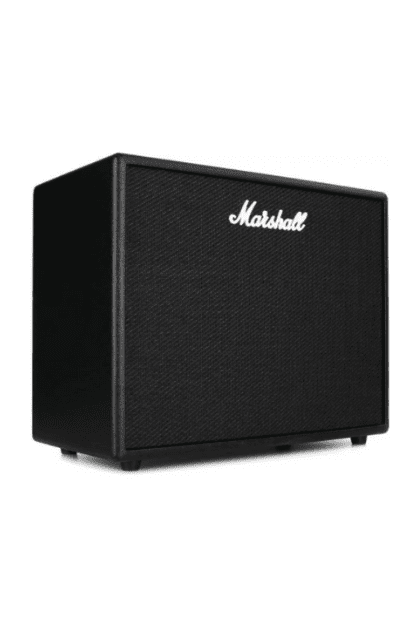
Marshall Code 50
One of the best ways to get authentic Marshall tones from a modeling amp.
This is easily one of the best looking combos Marshall has ever made. While good looks are a nice to have, the real attraction with the Code 50 is the superb Marshall amp models contained within. If you've ever wanted a whole range of authentic Marshall tones but don't have the space (or money) to buy them all, consider this a great alternative.
Of course, Marshall is a brand that needs no introduction, but perhaps their Code series of modeling amps do! The Code 50 is part of a new family of Marshall amplifiers that has hopped on the trend of creating digital recreations of famous models. It’s everything you’d expect from a Marshall and maybe a bit more!
This is a 50-watt combo amp with a single 12” speaker. We found it to have ample volume for small gigs, but it might struggle to be heard over an enthusiastic drummer. Even though it’s made with a 1×12” setup, there are actually multiple speaker-setup emulations, so it can digitally recreate the sound of a 4×12”, although it doesn’t have the volume to back it up.
As far as amp models are concerned, the Code 50 is pre-loaded with 14 pre amps and 4 power amps, all modeled after famous Marshalls, from the Bluesbreaker Plexi to the Silver Jubilee. The models really were great, and sounded a lot like the real things, but it would have been nice to see emulations of non-Marshall amps too.
The Code 50 also comes preloaded with 24 different modulation, delay and reverb FX. The onboard editing function was definitely nice to have, although it came with quite a learning curve. In order to create signal-chain presets and make other advanced edits, it’s much easier to use the Marshall Gateway mobile app than the edit dial. Gateway was pretty straightforward to use and the Bluetooth connection was fast and reliable. The code can take a footswitch too, which makes switching between FX feel much more natural.
Verdict: The Marshall Code 50 is perfect for the Marshall Amplification fan who dreams of owning and playing classic models, but who might not have the space (or budget) for it. It’s a great combo amp that works well for practice and small solo gigs, but likely won’t be able to cut through a full mix (although the available 100-watt version probably would work well). The recreations of Marshall amps that it produces are really excellent, but if we could change anything, we‘d add more variety in the amp and cab selection.
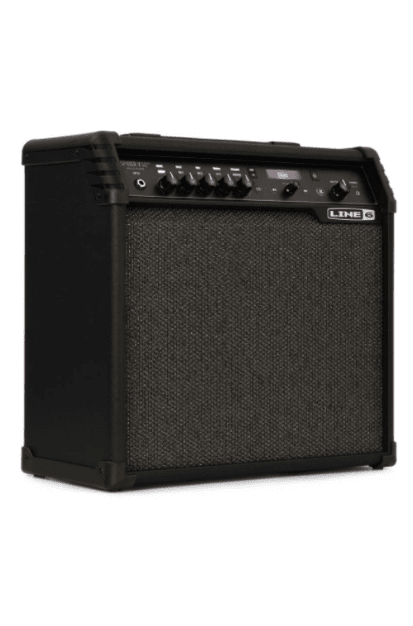
Line 6 Spider V 60
A great combo with tons of amps, cabs and FX to choose from.
Line 6 were some of the early pioneers of amplifier modeling, and their spider series has been a stalwart throughout. It offers light weight, small footprint performance, and offers the bedroom player everything they need to get started in amplifier modeling.
Line 6 was one of the earliest pioneers of modeling amps. With so much heritage in the niche, they make a great range of modelers, from the simple Spider combo line to the more advanced Helix range.
The Spider V 60 MKII offered a much more organic tonal experience than its predecessor, the MKI. It comes loaded with a huge number of presets. There are over 200 amp and pedal models right out of the box, many of which are based on famous models ranging from classic Fenders to modern Mesa Boogies. The amp models were mostly very good, although it’s questionable whether they accurately reflect the examples they’re inspired by.
Overall sound quality was great. The cab houses a single 10” woofer and a tweeter for accurate treble representation. Another neat feature on this amp is the Classic Speaker mode, which effectively turns off the modeling and reverts the amp to a regular solid state without the digital influence. It’s loaded with a RelayG10 compatible wireless receiver, although the transmitter is not included.
At bedroom levels, the Spider V MKII does lose some of the more appealing aspects of its tone, which is genuinely a shame. Had it been fitted with a power selector like the Boss Katana, that may have been a different story.
Modifications to models and downloads of new plugins all come via the Line 6 Spider V Remote app. This was one of the weaker points of this amp. The software was a little laggy and it took longer than other models to upload changes to the amp.
Verdict: The Line 6 Spider V 60 MKII is a solid all-rounder. It has some features a solo guitarist might find appealing, including drum loops and a built-in looper, as well as a wide selection of pedals and amp models. The software wasn’t as good as some of the other amps we tested, but it’s a great choice if you’re looking for a turn-key package and you’re not too interested in modifying presets.
How To Choose the Right Modeler For You
When it comes to picking out the best modeling amps, there are a few things you should really watch for to ensure you’re getting the right model for your particular needs. Having the most features, or the most expensive amp, doesn’t necessarily mean you’ll get the best modeling amp for you.
Generic vs. Popular Models
Are you looking to replicate your favorite artist’s tone or are you just trying to experiment with different sounds? This can make a big difference. If you’re hoping to emulate a specific guitarist’s rig, you’ll be best off with an amp that either has famous models built-in, or that can accept plugins for that specific model. Alternately, a profiler will do the job more effectively, but in most cases, you’ll be sacrificing having a power amp to get these precise emulations.
Effects
Another big factor is what effects you are looking for. Some models have a huge number of FX built in, while others are fairly limited. If you’re still planning to run an analog pedal board through your modeling amp, concentrate on finding the model that has the best emulations of the amps and cabs that you would want to play. If they aren’t built in, are they readily available as plugins?
Speakers and Power
What you’re planning to do with your amp is one of the most critical things to assess before you commit to purchase. If you’re looking to perform small gigs while still carrying as little gear as possible, you’ll probably want a combo amp with a minimum of 50 watts and at least one 10”-12” speaker. If you’ll be playing with a band and you’ve got the opportunity to plug into FOH, your options will open up a bit more, as many of the non-combo modelers and profilers can run directly into a PA. If you’re just looking for something for bedroom practice, any combo under 50 watts would be ideal.
If you’re looking at a high-end profiler, there’s a chance that you might also need to budget in a power amp and cabinet if you’re hoping to use them live and not just as an interface.
Final Thoughts
The world of modeling amps is expanding at an unprecedented rate. So if you’ve been put off by digital emulations in the past, you can rest assured that today’s selection of the best modeling amps are more advanced and sound far superior to older models.
To recap, we found that the Boss Katana 50 MKII was our Top Choice as an all-around blend of sound, features and price. If you’re looking for the best possible value, then consider the Yamaha THR5. If you’re looking for the best profiler or modeler available and you aren’t too concerned about the cost, look no further than the Neural DSP Quad Cortex.

